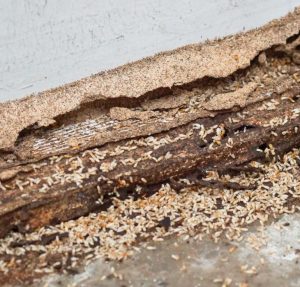How To Prevent Termite Swarms From Invading Your Home
Guest Post from Lara Graham
 If you see a swarm of flying insects that have wings, you’ll probably assume you’re seeing an ant.
If you see a swarm of flying insects that have wings, you’ll probably assume you’re seeing an ant.
But you could be seeing a more concerning phenomenon – flying termites.
If you spot these pests, you know that there is a termite colony in your near your property.
When a colony is well established, it begins to produce winged bugs that start a new breeding cycle.
Once a new colony is established in your home, the termites can cause thousands of damage to your house.
Worse, you may not even know it’s happening, as they usually do it out of sight and can eat away at your home for ages without you ever suspecting it.
If you see swarming termites, it could mean you have the opportunity to stop them before they infest your home.
Alternatively, it means there is a large colony on your property, and it’s crucial to call in a pest control professional to find the nests in your home or yard.
Before you panic, you want to ensure you are dealing with termites in the first place.
Read on to discover how to identify swarming termites, what it means if you have flying termites, and what you can do to get rid of them.
What Swarming Termites Look Like
Homeowners often confuse ants with termites. Here is how you can confirm if you are looking at a swarming termite:
-
-
-
The insect is small, about half an inch long
-
It has a head, thorax, and abdomen (tri-segmented body) and has six legs
-
It is the honey-colored or cream but can range to black depending on the species of termite<
-
It has two pairs of wings that are the same size
-
The antennae are straight (ants antennae are bent)
-
The abdomen of a termite is straight (an ant is pinched)
-
-
Spot the clues
While termites have been known to swarm at random times of the year, they typically do so in spring and summer when sexually mature adults leave the colony to establish new ones.
They tend to appear when the temperature soars and you have experienced heavy rain usually appearing between dusk and 11pm.
If you suspect swarming termites but were not awake during these hours, look for discarded body parts such as their papery wings. Inspect the floor, ground, or around windows and doors.
As discussed, swarmers leave a colony when the colony needs to grow.
It takes about three years to reach a point where mature ants embark on this new journey.
If you spot swarming termites, you should call in a pest control team to inspect your property for other signs of termite activity and pinpoint the nests.
Regardless of whether the colony is inside the house or not, what you really need to know is how much damage has already been done.
So, you should look for additional signs you have termites to determine if you have an infestation. These can include the following:
-
Damaged wood, such as hollowed-out skirting boards or buckling of beams
-
Wet patches on walls and other signs of moisture
-
Fine sawdust called frass, which is a waste material left by termites
-
Mud tunnels that lead from the ground and run along the walls of the foundation and crawl spaces.
Termite control isn’t something you can tackle on your own or with store-bought DIY products.
A trained and qualified pest control technician will give you professional advice on how to deal with swarming termites, and recommend a long-term prevention solution.
You want to find a way to prevent termites from entering your property, and also setting up systems that warn you when they’re around.